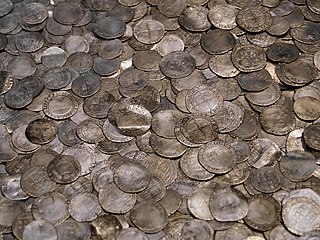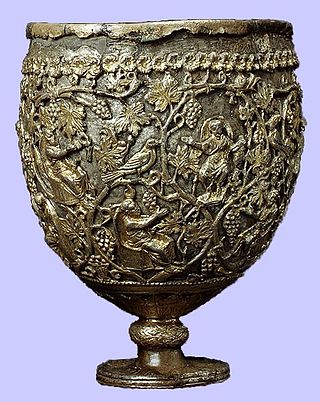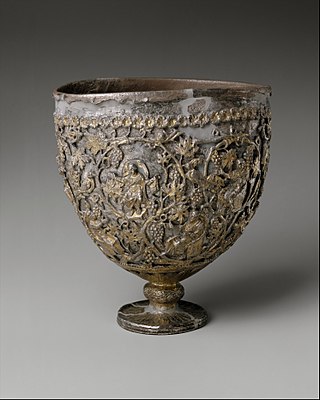
The Kaper Koraon Treasure is a Byzantine silver treasure consisting of 56 individual silver items originating from Syria in the sixth and seventh centuries.

The Kaper Koraon Treasure is a Byzantine silver treasure consisting of 56 individual silver items originating from Syria in the sixth and seventh centuries.
The treasure was re-discovered between 1908 and 1910. It was originally believed to have belonged to the church in Antioch, a thriving Roman city on the Mediterranean. It can now be argued that the items come from a larger collection of silver from the church of Saint Sergios in modern-day Kurin, Syria or that the pieces belonged to a small local church. [1] The final items of the collection were likely interred at the site in the seventh century as the Byzantine Empire subsequently lost this area of Syria to the Persian army. The later conquering by the Muslim Arab army permanently removed the area from Byzantine control. [1]
It is believed that the Persian and Muslim Arab take-overs were relatively peaceful as historic sites around the area show little to no damage that could be attributed to that time. Though religion began to shift following the change of power and Christian artifacts were increasingly stored away from public viewing, the area did continue to benefit from relative wealth and prosperity, creating many secular works. The real halt to production of silver treasures is thought to have followed a plague throughout the area from 542 to 544. This had a lasting impact on the economic status of the region. [2]
There is evidence that this accumulation of local wealth in silver objects was common throughout the area leading up to the Persian control and the sixth century plague. Similar treasures have been found at Stuma, Riha, Hama, and Antioch to name a few. [2]
The objects found in the Kaper Koraon treasure were not originally prestigious shrine gifts but were likely relatively cheap imitations made specifically for a village church. This can be clearly seen from recent investigations into the pieces which have shown high quantities of copper and other metals melted in with the silver to increase malleability and decrease production costs. It is estimated that these items were the collective donations from five local families over a period of at least three decades. Many of the stamps present on the pieces are believed to have been added after production and some note the specific donors of each piece. [3]
The Kaper Koraon treasure consists of 56 total silver objects including: eight chalices, seven patens, five crosses, one cross revetment, two lamp stands, three lamps, three ewers, one flask, one bowl, one mirror, one box, eleven spoons, one ladle, two strainers, two fans, and four plaques. The other three objects are only partial pieces of broken fragments likely from other plaques. Many of the items are religious in nature including images of the cross and Jesus's disciples. [4] Some are believed to be secular but were stored with the church collection either for safe-keeping on behalf of the owner or stores of wealth for the parish. [3]
Most of the silver pieces shown here still show evidence of hammering either visibly or through careful machine investigation. Due to the limited skill level of local workers and the overworking of malleable metal, many items featured here have stress fractures or chips that were original to the piece. Any repairs visible, such as the re-welding of a handle onto an ewar, are likely original and occurred before the internment of the treasure. Many of the chalices were hammered, welded together, and then lathed to smooth out the seams between the cup and the stem. Some chalices shows signs of wear at these seams and around the top rim due to the method of their construction. [3]
Since their discovery, the items of the Kaper Koraon treasure have dispersed into public and private collections throughout the world including The Walters Art Museum.

A hoard or "wealth deposit" is an archaeological term for a collection of valuable objects or artifacts, sometimes purposely buried in the ground, in which case it is sometimes also known as a cache. This would usually be with the intention of later recovery by the hoarder; hoarders sometimes died or were unable to return for other reasons before retrieving the hoard, and these surviving hoards might then be uncovered much later by metal detector hobbyists, members of the public, and archaeologists.
The Treaty of Devol was an agreement made in 1108 between Bohemond I of Antioch and Byzantine Emperor Alexios I Komnenos, in the wake of the First Crusade. It is named after the Byzantine fortress of Devol. Although the treaty was not immediately enforced, it was intended to make the Principality of Antioch a vassal state of the Byzantine Empire.

Cloisonné is an ancient technique for decorating metalwork objects with colored material held in place or separated by metal strips or wire, normally of gold. In recent centuries, vitreous enamel has been used, but inlays of cut gemstones, glass and other materials were also used during older periods; indeed cloisonné enamel very probably began as an easier imitation of cloisonné work using gems. The resulting objects can also be called cloisonné. The decoration is formed by first adding compartments to the metal object by soldering or affixing silver or gold as wires or thin strips placed on their edges. These remain visible in the finished piece, separating the different compartments of the enamel or inlays, which are often of several colors. Cloisonné enamel objects are worked on with enamel powder made into a paste, which then needs to be fired in a kiln. If gemstones or colored glass are used, the pieces need to be cut or ground into the shape of each cloison.

The Holy Chalice, also known as the Holy Grail, is in Christian tradition the vessel that Jesus used at the Last Supper to serve wine. The Synoptic Gospels refer to Jesus sharing a cup of wine with the Apostles, saying it was the covenant in his blood. The use of wine and chalice in the Eucharist in Christian churches is based on the Last Supper story. In the late 12th century, the author Robert de Boron associated the pre-existing story of the Holy Grail, a magical item from Arthurian literature, with the Holy Chalice. This association was continued in many subsequent Arthurian works, including the Lancelot-Grail (Vulgate) cycle, the Post-Vulgate Cycle, and Sir Thomas Malory's Le Morte d'Arthur. A cup kept in the Spanish Cathedral of Valencia has been identified since Medieval times as the purported Holy Chalice used at the Last Supper.

Niello is a black mixture, usually of sulphur, copper, silver, and lead, used as an inlay on engraved or etched metal, especially silver. It is added as a powder or paste, then fired until it melts or at least softens, and flows or is pushed into the engraved lines in the metal. It hardens and blackens when cool, and the niello on the flat surface is polished off to show the filled lines in black, contrasting with the polished metal around it. It may also be used with other metalworking techniques to cover larger areas, as seen in the sky in the diptych illustrated here. The metal where niello is to be placed is often roughened to provide a key. In many cases, especially in objects that have been buried underground, where the niello is now lost, the roughened surface indicates that it was once there.


The Water Newton Treasure is a hoard of fourth-century Roman silver, discovered near the location of the Roman town of Durobrivae at Water Newton in the English county of Cambridgeshire in 1975. The hoard consisted of 27 silver items and one small gold plaque. Because of inscriptions found on some of the pieces in the collection it has been suggested that they may have been used in a local church, and they therefore comprise the earliest probable group of Christian liturgical silver yet found in the Roman Empire.

Looted art has been a consequence of looting during war, natural disaster and riot for centuries. Looting of art, archaeology and other cultural property may be an opportunistic criminal act or may be a more organized case of unlawful or unethical pillage by the victor of a conflict. The term "looted art" reflects bias, and whether particular art has been taken legally or illegally is often the subject of conflicting laws and subjective interpretations of governments and people; use of the term "looted art" in reference to a particular art object implies that the art was taken illegally.

The Oxus treasure is a collection of about 180 surviving pieces of metalwork in gold and silver, most relatively small, and around 200 coins, from the Achaemenid Persian period which were found by the Oxus river about 1877–1880. The exact place and date of the find remain unclear, but is often proposed as being near Kobadiyan. It is likely that many other pieces from the hoard were melted down for bullion; early reports suggest there were originally some 1500 coins, and mention types of metalwork that are not among the surviving pieces. The metalwork is believed to date from the sixth to fourth centuries BC, but the coins show a greater range, with some of those believed to belong to the treasure coming from around 200 BC. The most likely origin for the treasure is that it belonged to a temple, where votive offerings were deposited over a long period. How it came to be deposited is unknown.

The Museum of Byzantine Culture is a museum in Thessaloniki, Central Macedonia, Greece, which opened in 1994.

The Monza ampullae form the largest collection of a specific type of Early Medieval pilgrimage ampullae or small flasks designed to hold holy oil from pilgrimage sites in the Holy Land related to the life of Jesus. They were made in Palestine, probably in the fifth to early seventh centuries, and have been in the Treasury of Monza Cathedral north of Milan in Italy since they were donated by Theodelinda, queen of the Lombards,. Since the great majority of surviving examples of such flasks are those in the Monza group, the term may be used to cover this type of object in general.

The Middle Ages was a period that spanned approximately 1000 years and is normally restricted to Europe and the Byzantine Empire. The material remains we have from that time, including jewelry, can vary greatly depending on the place and time of their creation, especially as Christianity discouraged the burial of jewellery as grave goods, except for royalty and important clerics, who were often buried in their best clothes and wearing jewels. The main material used for jewellery design in antiquity and leading into the Middle Ages was gold. Many different techniques were used to create working surfaces and add decoration to those surfaces to produce the jewellery, including soldering, plating and gilding, repoussé, chasing, inlay, enamelling, filigree and granulation, stamping, striking and casting. Major stylistic phases include barbarian, Byzantine, Carolingian and Ottonian, Viking, and the Late Middle Ages, when Western European styles became relatively similar.

The Esquiline Treasure is an ancient Roman silver treasure that was found in 1793 on the Esquiline Hill in Rome. The hoard is considered an important example of late antique silver work from the 4th century AD, probably about 380 for the major pieces. Since 1866, 57 objects, representing the great majority of the treasure, have been in the British Museum.

The First Cyprus Treasure or Lamboussa Treasure is the name of a major early Byzantine silver hoard found near Kyrenia, Cyprus. Currently in the British Museum's collection, the treasure is largely composed of liturgical objects that may have belonged to an ancient church or monastery. It is called the First Cyprus Treasure to distinguish it from the so-called Second Cyprus Treasure, which is now split between the Metropolitan Museum of Art and the Cyprus Museum.

The Lampsacus Treasure or Lapseki Treasure is the name of an important early Byzantine silver hoard found near the town of Lapseki in modern-day Turkey. Most of the hoard is now in the British Museum's collection, although a few items can be found in museums in Paris and Istanbul too.

The Mosaic Fragment with Man Leading a Giraffe is a mosaic from the 5th century CE, now held in the Art Institute of Chicago. The piece is Byzantine and originated in northern Syria or Lebanon. Mosaics of this type were commonly used to decorate wealthy family villas.

Silver was important in Byzantine art and society more broadly as it was the most precious metal right after gold. Byzantine silver was prized in official, religious, and domestic realms. Aristocratic homes had silver dining ware, and in churches silver was used for crosses, liturgical vessels such as the patens and chalices required for every Eucharist. The imperial offices periodically issued silver coinage and regulated the use of silver through control stamps. About 1,500 silver plates and crosses survive from the Byzantine era.

Byzantine glass objects highly resembled their earlier Hellenistic counterparts during the fourth and early fifth centuries CE in both form and function. Over the course of the fifth century CE, Byzantine glass blowers, based mostly in the area of Syria and Palestine, developed a distinct Byzantine style. While glass vessels continued to serve as the primary vehicles for pouring and drinking liquid, glassware for lighting, currency and commodity weights, window panes, and glass tesserae for mosaics and enamels also surged in popularity. Following the Arab conquests of the seventh century CE, large quantities of glass were imported from the Levant, which continued to produce raw and manufactured glass. Scholars once believed that glassware was an expensive luxury good reserved for the upper strata of society, however, recent archaeological excavations have unearthed a considerable quantity of unadorned glassware intended for lower-class residents.

The silver-gilt Antioch chalice was created around AD 500-550. Currently it is on view at The Metropolitan Museum of Art Fifth Avenue in Gallery 300. When it was discovered, the interior cup of the chalice was initially considered to be the Holy Chalice, the cup used by Christ at the Last Supper. Recently, it has been concluded that it may have been a standing oil lamp and not a chalice.
Marlia Mundell Mango is a Byzantine archaeologist and historian at the University of Oxford, where she was University Lecturer in Byzantine Archaeology and Art (1995–2008).